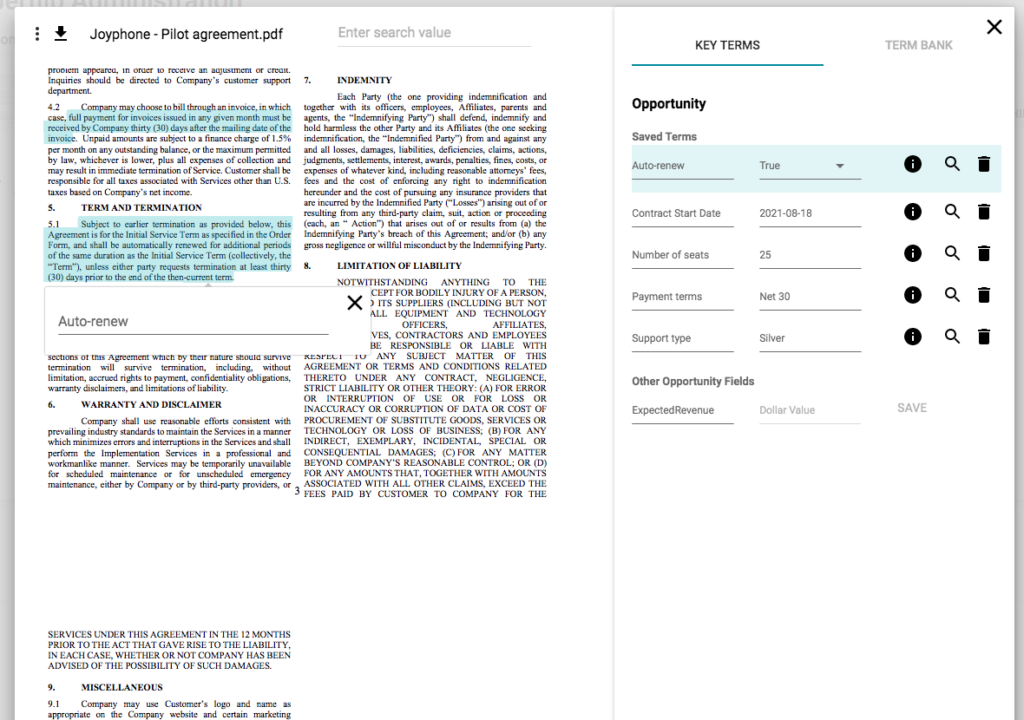
Meet Paperflip, a new NLP-driven contract management and analytics application that operates within the Salesforce ecosystem.
Now, many in the legal world may immediately ask: ‘What? Salesforce? That’s what businesses use for CRM and sales, isn’t it?’
And that’s right. It’s the place where many businesses hold their sales data – data which is derived from sales contracts. And, for a very large proportion of businesses these contracts constitute their core repository of legal obligations and agreements with other parties.
Hence, if you really want to get into a company’s legal documents in a truly seamless way, then why not integrate an NLP platform with Salesforce that can analyse and extract key data points related to the often thousands of contracts generated by the sales team, and then store those obligations, renewal dates, non-standard terms and more, inside of Salesforce?
This is exactly what Paperflip’s Californian founders Tim Cederman-Haysom and David Wong (pictured above) have done. And it looks like a great idea.
In broad terms what Paperflip does is extract the deal terms from executed contracts and ensures your Salesforce data is correctly populated.
How it works: you drag and drop contracts directly into Salesforce and Paperflip extracts clauses, non-standard terms and order details, immediately syncing them to your Salesforce fields.
Artificial Lawyer caught up with Cederman-Haysom and Wong to hear their story.
They started out at SurveyMonkey, and like many founders eventually uncovered a problem that needed to be solved. In this case it was keeping track of contract obligations. This was being done manually. There had to be a better way.
They looked at a variety of legal AI doc analysis solutions, but came to the decision to build their own.
‘It was not meant to be a ‘legal tech’ product,’ they explained. ‘It was created to focus on contractual obligations.’
But, inevitably once you get into contractual obligations and the analysis of them you end up in the legal world. Where they are now is a sign of a growing trend for a crossover between the wider commercial world of sales contracting processes and the legal sector.
Strangely, the two business areas have seemed to operate as if they were focused on two separate things – rather than exactly the same thing, namely: contracts.
After all, how can a ‘legal contract’ be any different to a ‘contract’? Yet, people use the terms unconsciously to suggest the former represents a complex agreement, while the latter is ‘just a sales agreement’. And that is just the siloed way ‘legal’ in businesses has evolved.
Moving on….
‘Almost all the companies we knew used Salesforce,’ they explained. ‘And we wanted to keep that as part of the solution because the metadata from the contracts was in Salesforce.’
Cederman-Haysom and Wong added: ‘The idea was to therefore build Paperflip into this workflow.’
Their central philosophy is that it’s the sales teams that are creating these contracts, and then using Salesforce as their ‘central repository of truth’ about all those deals. It makes sense then to stay inside this ecosystem and avoid creating a new silo.
‘Salesforce is a single version of truth for these contracts,’ they conclude.
On the technical side their ‘document intelligence engine’, which extracts the text, with OCR if necessary, regardless of document format, utilises NLP, plus rules-based and applied machine learning to extract key terms. Paperflip also supports importing from DocuSign or email.
However, there also appears to be some human intervention that needs to take place to provide the level of result accuracy companies require.
‘We don’t aim for totally automated analysis,’ they said. ‘People don’t want 100% automation, so we have an augmented approach.’
How scalable additional human input will be isn’t clear yet, but it’s fair to say the company is still evolving.
The duo add that although this is heavily focused on Salesforce right now, they could see a similar approach in other areas of business, such as HR, finance and procurement.
This all makes a lot of sense. Why make the analysis and management of legal obligations….or dare we say it, just ‘obligations’……into a totally separate silo, far away from the people who are creating those contracts in the first place?
It will be interesting to see where this goes. For now, Paperflip is a relatively small team, but if they get significant buy-in from corporates the idea could take off.
(Here’s a short video that walks you through the basics (about 4 mins) – also see a screen shot below.)
—
Also, if you’d like to learn more there is a webinar on the 16 Oct – register here.
—

In my prior two companies we stored all contracts and managed invoicing via Salesforce, so this is a clever integration. Most of the contract analytics folks have been focusing on Word integrations, due to their contract drafting perspectives.
What’s interesting about PaperFlip is that by integrating with Salesforce they are beginning their journey into billing, as many companies generate invoices based on Salesforce. Thus a contract isn’t about mitigating risk and looking at assignability clauses, but about ensuring revenue & cash flow for an organisation. Ensuring that renewals and price increases in contracts are reflected in invoices.
LegalTech + FinTech